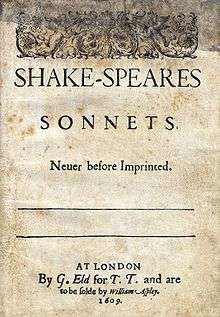Sonnet 96
Sonnet 96 is one of 154 sonnets written by the English playwright and poet William Shakespeare. It is a member of the Fair Youth sequence.
| Sonnet 96 | |||||||
|---|---|---|---|---|---|---|---|
 The first five lines of Sonnet 96 in the 1609 Quarto | |||||||
| |||||||
Synopsis
The young man is praised for the charms found in both his faults and his good qualities; if he wanted to he could "lead away" or seduce even more of those who gaze at him. In the final couplet the speaker urges him: Do not, because since the young man's good reputation is in part based on his faults, if he goes too far those faults could be a danger to both of their reputations. The final couplet is identical to the final couplet of sonnet 36. Each couplet however has a different meaning according to the context of each sonnet.[2]
Structure
Sonnet 96 is an English or Shakespearean sonnet, which is composed of three quatrains, and a final rhyming couplet. The poem's lines follow the rhyme scheme ABAB CDCD EFEF GG, and are written in iambic pentameter: Five feet, each with two syllables accented weak/strong.
The 3rd line is an example of a regular iambic pentameter:
× / × / × / × / × / Both grace and faults are lov'd of more and less: (96.3)
- / = ictus, a metrically strong syllabic position. × = nonictus.
The 9th line presents a case of metrical ambiguity. Probably the simplest scansion features only one metrical variation, a reversal of the accents in the third foot:
× / × / / × × / × / How many lambs might the stern wolf betray, (96.9)
However, the line may be read differently, depending upon the reader's interpretation. The line may be scanned with an initial reversal, and with the rightward movement of the third ictus (resulting in a four-position figure, × × / /, sometimes referred to as a minor ionic):
/ × × / × × / / × / How many lambs might the stern wolf betray, (96.9)
The meter calls for a few variant pronunciations: line 5's "thronèd" is two syllables,[3] and line 14's "being" is one.[4] In lines 8 and 10 "translated" and "translate" are both stressed on the second syllable.[5]
Notes
- Shakespeare, William. Duncan-Jones, Katherine. Shakespeare’s Sonnets. Bloomsbury Arden 2010. p. 303 ISBN 9781408017975.
- Shakespeare, William. Duncan-Jones, Katherine. Shakespeare’s Sonnets. Bloomsbury Arden 2010. p. 302 ISBN 9781408017975.
- Booth 2000, p. 83.
- Booth 2000, p. 313.
- Groves, Peter (2013). Rhythm and Meaning in Shakespeare: A Guide for Readers and Actors. Melbourne: Monash University Publishing. p. 170. ISBN 978-1-921867-81-1.
References
- First edition and facsimile
- Shakespeare, William (1609). Shake-speares Sonnets: Never Before Imprinted. London: Thomas Thorpe.CS1 maint: ref=harv (link)
- Lee, Sidney, ed. (1905). Shakespeares Sonnets: Being a reproduction in facsimile of the first edition. Oxford: Clarendon Press. OCLC 458829162.
- Variorum editions
- Alden, Raymond Macdonald, ed. (1916). The Sonnets of Shakespeare. Boston: Houghton Mifflin Company. OCLC 234756.
- Rollins, Hyder Edward, ed. (1944). A New Variorum Edition of Shakespeare: The Sonnets [2 Volumes]. Philadelphia: J. B. Lippincott & Co. OCLC 6028485.
- Modern critical editions
- Atkins, Carl D., ed. (2007). Shakespeare's Sonnets: With Three Hundred Years of Commentary. Madison: Fairleigh Dickinson University Press. ISBN 978-0-8386-4163-7. OCLC 86090499.
- Booth, Stephen, ed. (2000) [1st ed. 1977]. Shakespeare's Sonnets (Rev. ed.). New Haven: Yale Nota Bene. ISBN 0-300-01959-9. OCLC 2968040.
- Burrow, Colin, ed. (2002). The Complete Sonnets and Poems. The Oxford Shakespeare. Oxford: Oxford University Press. ISBN 978-0192819338. OCLC 48532938.
- Duncan-Jones, Katherine, ed. (2010) [1st ed. 1997]. Shakespeare's Sonnets. The Arden Shakespeare, Third Series (Rev. ed.). London: Bloomsbury. ISBN 978-1-4080-1797-5. OCLC 755065951.
- Evans, G. Blakemore, ed. (1996). The Sonnets. The New Cambridge Shakespeare. Cambridge: Cambridge University Press. ISBN 978-0521294034. OCLC 32272082.
- Kerrigan, John, ed. (1995) [1st ed. 1986]. The Sonnets ; and, A Lover's Complaint. New Penguin Shakespeare (Rev. ed.). Penguin Books. ISBN 0-14-070732-8. OCLC 15018446.
- Mowat, Barbara A.; Werstine, Paul, eds. (2006). Shakespeare's Sonnets & Poems. Folger Shakespeare Library. New York: Washington Square Press. ISBN 978-0743273282. OCLC 64594469.
- Orgel, Stephen, ed. (2001). The Sonnets. The Pelican Shakespeare (Rev. ed.). New York: Penguin Books. ISBN 978-0140714531. OCLC 46683809.
- Vendler, Helen, ed. (1997). The Art of Shakespeare's Sonnets. Cambridge, MA: The Belknap Press of Harvard University Press. ISBN 0-674-63712-7. OCLC 36806589.
.png)
